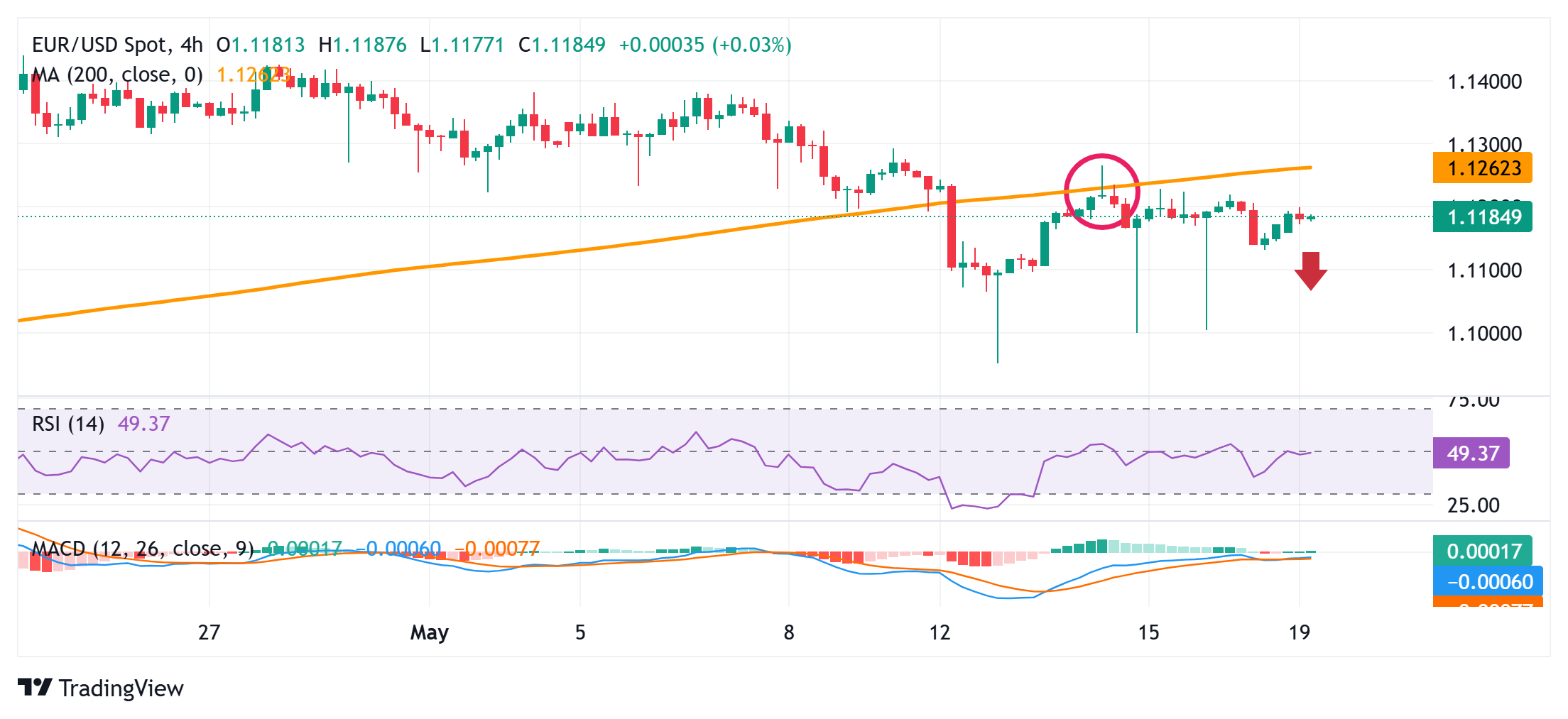EUR/USD Price Forecast: Seems vulnerable below 1.1200, 200-period SMA on H4 holds the key
- EUR/USD trades with a positive bias on Monday amid a modest USD downtick.
- The setup warrants caution for bulls and before positioning for further gains.
- A sustained move beyond the 1.1300 mark might negate the negative outlook.
The EUR/USD pair ticks higher at the start of a new week amid a softer US Dollar (USD), though it lacks bullish conviction and remains below the 1.1200 round figure through the Asian session.
From a technical perspective, last week's breakdown below the 200-period Simple Moving Average (SMA) on the 4-hour chart was seen as a key trigger for bearish traders. This, along with slightly negative oscillators on the 4-hour/daily charts, suggests that the path of least resistance for the EUR/USD pair is to the downside. Hence, any subsequent move up beyond the 1.1200 mark could be seen as a selling opportunity near the 1.1275-1.1280 region.
However, some follow-through buying, leading to a subsequent strength beyond the 1.1300 mark, will negate the negative bias and trigger a short-covering move. The EUR/USD pair might then surpass an intermediate hurdle and reclaim the 1.1400 round figure. The momentum could extend further towards the 1.1430 resistance zone en route to the 1.1500 psychological mark and the 1.1570-1.1570 region, or a multi-year top touched in April.
On the flip side, the 1.1130 area could offer some support ahead of the 1.1100 round-figure mark and the monthly swing low, around the 1.1080 region. A convincing break below the latter will reaffirm the negative outlook and make the EUR/USD pair vulnerable to accelerating the fall further towards challenging the 1.1000 psychological mark.
EUR/USD 4-hour chart

Euro FAQs
The Euro is the currency for the 19 European Union countries that belong to the Eurozone. It is the second most heavily traded currency in the world behind the US Dollar. In 2022, it accounted for 31% of all foreign exchange transactions, with an average daily turnover of over $2.2 trillion a day. EUR/USD is the most heavily traded currency pair in the world, accounting for an estimated 30% off all transactions, followed by EUR/JPY (4%), EUR/GBP (3%) and EUR/AUD (2%).
The European Central Bank (ECB) in Frankfurt, Germany, is the reserve bank for the Eurozone. The ECB sets interest rates and manages monetary policy. The ECB’s primary mandate is to maintain price stability, which means either controlling inflation or stimulating growth. Its primary tool is the raising or lowering of interest rates. Relatively high interest rates – or the expectation of higher rates – will usually benefit the Euro and vice versa. The ECB Governing Council makes monetary policy decisions at meetings held eight times a year. Decisions are made by heads of the Eurozone national banks and six permanent members, including the President of the ECB, Christine Lagarde.
Eurozone inflation data, measured by the Harmonized Index of Consumer Prices (HICP), is an important econometric for the Euro. If inflation rises more than expected, especially if above the ECB’s 2% target, it obliges the ECB to raise interest rates to bring it back under control. Relatively high interest rates compared to its counterparts will usually benefit the Euro, as it makes the region more attractive as a place for global investors to park their money.
Data releases gauge the health of the economy and can impact on the Euro. Indicators such as GDP, Manufacturing and Services PMIs, employment, and consumer sentiment surveys can all influence the direction of the single currency. A strong economy is good for the Euro. Not only does it attract more foreign investment but it may encourage the ECB to put up interest rates, which will directly strengthen the Euro. Otherwise, if economic data is weak, the Euro is likely to fall. Economic data for the four largest economies in the euro area (Germany, France, Italy and Spain) are especially significant, as they account for 75% of the Eurozone’s economy.
Another significant data release for the Euro is the Trade Balance. This indicator measures the difference between what a country earns from its exports and what it spends on imports over a given period. If a country produces highly sought after exports then its currency will gain in value purely from the extra demand created from foreign buyers seeking to purchase these goods. Therefore, a positive net Trade Balance strengthens a currency and vice versa for a negative balance.

